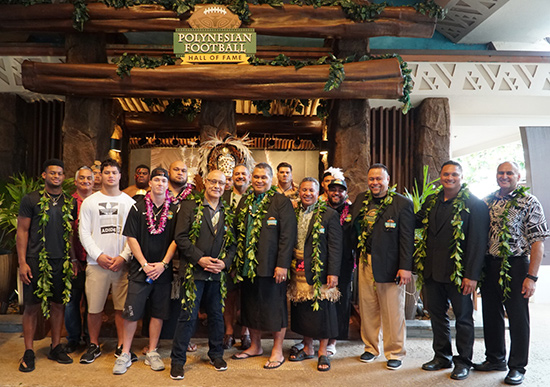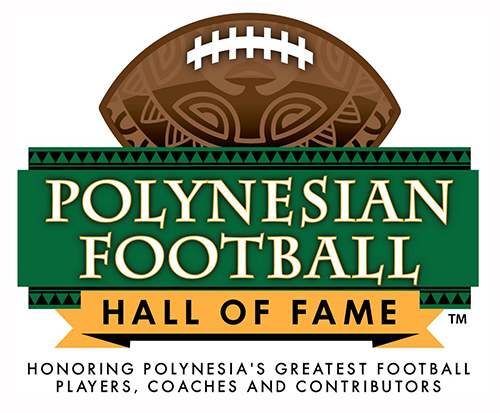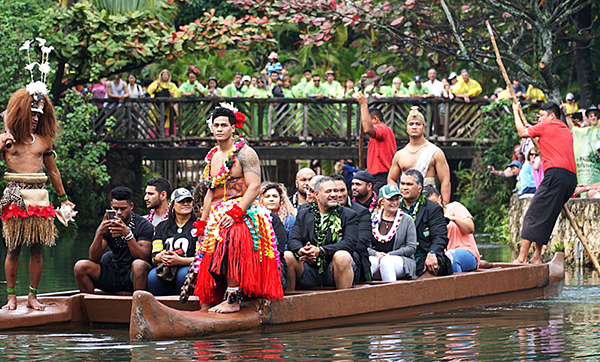
The Class of 2018 and others in front of the Polynesian Football Hall of Fame gallery at the Polynesian Cultural Center in Laie, Hawaii, on January 20, 2018. (Polynesian Cultural Center photo)
The Polynesian Football Hall of Fame (PFHOF) inducted its Class of 2018 during an enshrinement program at the Polynesian Cultural Center on Jan. 20, 2018.
FYI, the Center partnered with the PFHOF five years ago to host the hall of fame’s permanent gallery, which is located in the Hukilau Marketplace and is open free to the public.

The Polynesian Football Hall of Fame Class of 2018
The five members of the PFHOF Class of 2018 enshrined that weekend include:
>> The late Herman “Buddy” Pi’ikea Clark Sr., (who died in 1989), was a Hawaiian OL related to the chiefly lines of Maui and Moloka’i. He enjoyed outstanding football success at Punahou in Honolulu and Oregon State University. His son, Herman Jr., said the Chicago Bears drafted his father in 1952 for $5,500 a season. “He certainly didn’t make a lot of money, but they played ferociously.”
The Army interrupted his pro career when they drafted him during the Korean conflict; he served by coaching their military team at Ft. Shafter in Waikiki. Returning to the Bears after, he was a two-time All-Pro and was named to the NFL Half-Century Team. He later coached high school teams in Hawaii, and as chairman of the Aloha Stadium Authority, “was responsible for helping bring the Pro Bowl to Hawaii,” said emcee Vai Sikahema.
>> Ma’ake Kemoe’atu, a Tongan defensive nose tackle, played for Kailua then Kahuku High and the University of Utah, before being drafted by the Baltimore Ravens (he also played for the Carolina Panthers and the Washington Redskins. “Kahuku and the home town helped me a lot,” he said. “My dad, a minister, moved to Kahuku my junior year. It was a great opportunity for colleges to come take a look at me, which gave me opportunities. I have so much family here. Even though we live in another part of the island [Kapolei], we always come back to Kahuku” (see full story entitled Polynesian football legends: More than ‘warriors’.)
>> Manu Tuiasosopo, a Samoan DL, prepped at St. Anthony’s in Los Angeles, and won a scholarship to UCLAL: He was a four-year starter, three-time All Pac 10 selection, two-time All American, and played on the 1976 Rose Bowl championship team. The Seattle Seahawks drafted him 18th overall in the 1979 first round; the NFL All-Rookie Team tapped him that first season. He later won a Super Bowl ring playing for the San Francisco 49ers.
The Tuiasosopo’s five children are also outstanding athletes: Sons Marques and Zach played in the NFL, and Matt plays for the Atlanta Braves baseball team.
>> Kimo von Oelhoffen, a Hawaiian defensive tackle who grew up on the island of Moloka’i, which didn’t have a football team then, but he certainly learned by the time he played for Boise State, then spen 14 years with the Cincinnati Bengals, the Pittsburg Steelers, the New York Jets and the Philadelphia Eagles.
Von Oelhoffen said he was fortunate to grow up on Molokai, where “I was surrounded by compassion and hard work my whole life. One of the things I learned is that your heart is actually given to you by the people around you — and your family. Me coming here, and meeting these powerful men, they are some of the most compassionate men you’ve ever met.”
>> Bob Apisa, a Samoan RB recognized for contributing to the game as the “godfather of the Hawaii Polynesian pipeline”: He left American Samoa as a boy before they played football there, prepped at Farrington in Honolulu and won a scholarship to Michigan State. There, he was named an All American. He was also probably the first Samoan to play in the Rose Bowl (1966), and he helped the Spartans win a national championship with his skills. Apisa went on to play for the Green Bay Packers; but sharp-eyed movie fans might recognize him for his second-career working as a stunt man and actor.
He is quoted as saying that by going to Michigan State he represented not only himself and his family, but the Samoan community and Hawaii, too. He said this is what inspired him to get up mornings when it was 20º below zero in East Lansing and walk half-a-mile on crutches to an 8 a.m. class.
Others also honored during the enshrinement at the PCC
In addition to the Class of 2018 retired players, the following were also at the PFHOF enshrinement program at the Polynesian Cultural Center:
>> JuJu Smith-Schuster (Samoan, receiver, Pittsburg Steelers), PFHOF Polynesian rookie player of the year: Schuster-Smith, who said he grew up playing rugby, helped lead the Steelers to a 13-3 record in 2017 regular season play. He is the youngest player in NFL history to amass 1,000-plus all-purpose yards in a single season, and he set a franchise record for most receiving yards by a rookie player.
>> Hercules Mata’afa (Samoan, DL), PFHOF 2017 college football player of the year: As a junior at Washington State University in 2017, Mata’afa was named Associated Press Pac-12 Conference Defensive Player of the Year. He was also included on the Walter Camp, Sports Illustrated, TheAthletic.com, Football Writers Association of America, and Associated Press All-American teams.
>> McKenzie Kana’i Milton (quarterback, University of Central Florida, prepped at Mililani, which won the Hawaiian state championship): Milton, whose Hawaiian name means “the victor,” also took part in the enshrinement program for his role in recently leading UCF to the 2017 American Athletic Conference championship in double OT, for which he was named offensive MVP. As the AAC offensive player of 2017, he led the team to the 2018 Peach Bowl championship, for which he was named offensive MVP
During the press conference at the PCC, Sikahema also introduced PFHOF co-founders Jesse Sapolu, who said the “sacrifice that many people make is what makes this great Hall of Fame possible’; and Ma’a Tanuvasa. Sikahema also singled out his cousin, Norm Harris, the architect who designed the PFHOF at the PCC.

Polynesian Football Hall of Fame Class of 2018 and other honorees participate in the Polynesian Cultural Center canoe pageant on Jan. 20, 2018. (Polynesian Cultural Center photo)
Paying tribute to other outstanding Polynesian players
Later, Sikahema started his emcee remarks during the enshrinement program in the PCC’s Hawaiian Journey Theater, by honoring:
- Al Lolotai, the first Polynesian to play in the NFL, a member of the 1945 Washington Redskins. His wife and son, Ti’i, were in the audience.
- The first Polynesian inducted into College Football Hall of Fame, “Squirming” Herman Wedemeyer, a Hawaiian, 1979.
- Marcus Mariota, the first Polynesian to win the Heisman Trophy, 2015. Sikahema pointed out her recently saw Mariota lead the Tennessee Titans to the second round of the NFC playoff.
- Inaugural Polynesian Football Hall of Fame inductee Junior Seau — a 20-year NFL player and eight-time All Pro — was the first Polynesian inducted into the Pro Football Hall of Fame in Canton, Ohio, 2015. “And we expect there will be more who follow him,” Sikahema said.
Sikahema also pointed out:
- “The New Orleans Saints who have the most Polynesian players of any NFL team — I believe they have six — advanced to the second round of the playoffs.”
- “Just this year, Samoan Tua Tagovailoa was the first Polynesian to be named a football national championship MVP for the University of Alabama.
“Polynesians have, without a doubt, had a significant impact on the game of football,” Sikahema said.

Story by Mike Foley, who has been a full-time freelance writer and digital media specialist since 2002. Prior to that he had a long career in marketing communications, PR, journalism and university education. Foley learned to speak fluent Samoan as a Mormon missionary before moving to Laie in 1967 — and still does. He has traveled extensively over the years throughout Polynesia, other Pacific islands and Asia. Foley is mostly retired now, but continues to contribute to PCC and various other media.

Recent Comments